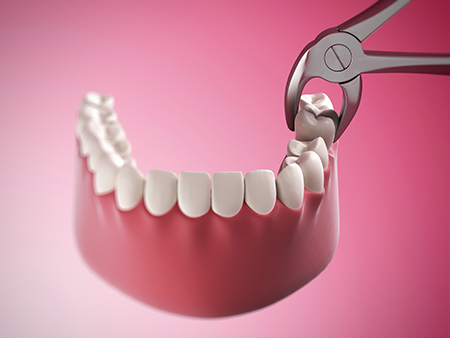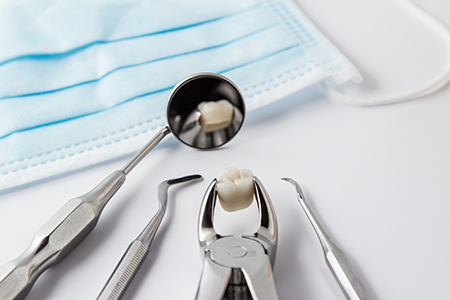At the office of Edward J. Sharkey, DMD, patient comfort and predictable results are our priorities. When a tooth cannot be saved or is causing harm to surrounding tissues, careful removal is often the most responsible path to preserve your long-term oral health. Our team focuses on clear communication, thorough evaluation, and a treatment plan that balances immediate needs with future restorations.
Tooth removal is a common dental procedure, but the decision to extract is never made lightly. We consider the tooth's structural integrity, the health of the gums and bone, and how preserving or removing a tooth will affect chewing, alignment, and overall wellness. Our goal is to protect function and appearance while minimizing discomfort and recovery time.
Understanding the reasons behind an extraction helps patients feel more confident in their care. Below are the most frequent scenarios that lead to recommendations for extraction, followed by straightforward explanations of what to expect before, during, and after the procedure.
Primary (baby) teeth that neither loosen nor fall out
Sometimes a primary tooth remains fixed in place when the permanent tooth below it is ready to erupt. This can block proper development or cause misalignment. When a baby tooth is over-retained—because its root has not resorbed or has fused to the bone—removal may be recommended to allow normal eruption of the permanent tooth.
Permanents that are too damaged for repair
Extensive decay or structural loss can leave a tooth without enough healthy material to support a filling or crown. When decay has progressed into the root or the remaining tooth structure cannot reliably support restoration, extraction becomes the safest option to prevent infection and further complications.
Teeth fractured beyond repair
Cracks and fractures range from minor chips to splits that extend below the gum line. If a fracture compromises the root or leaves insufficient tooth for restoration, extraction may be necessary to avoid recurrent pain, infection, and damage to neighboring teeth.
Advanced periodontal disease
When gum disease has significantly reduced the bone and soft tissue supporting a tooth, it may become loose or nonfunctional. In advanced cases, extraction can stop the progression of infection and create a healthier environment for neighboring teeth and future restorative work.
Impacted, poorly aligned, or decayed wisdom teeth
Third molars often erupt with limited space or at an angle that damages adjacent teeth or traps bacteria. When wisdom teeth cause pain, infection, or crowding—or are likely to in the future—removal is commonly recommended, especially for younger adults whose healing is typically faster.
Extractions as part of orthodontic planning
Occasionally, removing one or more permanent teeth is the most efficient way to correct severe crowding or to create a balanced bite in coordination with orthodontic treatment. When extractions support long-term function and alignment, they are planned carefully with the orthodontic team.

The first step in any extraction is a full review of your medical and dental history. We’ll ask about medications, previous surgeries, and any medical conditions that might affect healing or bleeding. If there are concerns such as a bleeding disorder or certain heart conditions, we will coordinate care with your physician and take any necessary precautions before scheduling the procedure.
We use modern imaging to evaluate root shape, bone levels, and the position of the tooth. Digital radiographs provide a clear picture so we can choose the most appropriate technique and anticipate potential complexities. If you are taking medications that affect clotting or immunity, we will review how to proceed safely.
Local anesthesia is standard to ensure the area is numb during the extraction. For patients who experience anxiety or require additional comfort, we offer sedation options and will discuss which method is best for you. Our emphasis is on minimizing stress and delivering precise, efficient care so recovery begins under the best conditions.
A simple extraction is appropriate when a tooth is fully accessible in the mouth and the roots are uncomplicated. We numb the area, loosen the tooth by gently detaching the ligament that holds it in place, and remove it with forceps. The procedure is typically brief, and most patients experience minimal discomfort afterward when they follow post-operative instructions.
Surgical extraction is used when a tooth is broken at the gum line, impacted, or has an unusual root shape. This approach may involve a small incision and the selective removal of bone to reach the tooth, or sectioning a tooth into pieces to remove it safely. Complex cases may be managed in our office or by a specialist depending on what will best protect the patient’s health and outcome.

Recovery after an extraction follows predictable stages, and following clear instructions helps avoid common complications. Rest and careful attention to the surgical site during the first 24–72 hours are key. You will receive individualized post-operative guidance that may include activity limits, prescriptions, and follow-up timing based on the complexity of your case.
Typical aftercare focuses on controlling bleeding, reducing swelling, managing pain, and protecting the clot that forms in the socket. Proper care prevents dry socket and infection, and it supports healthy bone and soft tissue healing that will make future restorative work easier and more predictable.
If you notice unusual symptoms—such as persistent heavy bleeding, increasing or severe pain, fever, or a foul taste—contact the office promptly so we can evaluate healing and intervene if necessary.
Applying and changing gauze
You will bite gently on gauze placed over the extraction site to help control bleeding. Change the gauze as instructed, typically after the first hour, and continue firm, steady pressure if bleeding persists. A small amount of oozing is normal for up to 24 hours.
Protect the area while numb
Avoid chewing, touching, or otherwise irritating the area until sensation returns to prevent accidental biting of lips, cheek, or tongue.
Medications and infection prevention
Antibiotics:
If prescribed, take the full course exactly as directed to reduce the risk of infection.
Pain management:
Start pain control while the anesthetic is still wearing off, and use over-the-counter or prescribed analgesics according to our instructions.
Protect the blood clot
Avoid rinsing vigorously, using a straw, or smoking for several days after the extraction to prevent dislodging the clot that supports healing.
Cold application
Use cold compresses on the face in short intervals during the first 24 hours to limit swelling and discomfort.
Smoking and tobacco
Avoid smoking for at least a week, as tobacco interferes with clot formation and slows healing.
Diet and fluids
Stick to cool, soft foods and avoid extremely hot or spicy items in the first 48 hours. Stay well hydrated with non-carbonated, non-alcoholic beverages.
Gentle oral hygiene
Brush carefully around the area and, after the first day or two, use a mild warm saltwater rinse to keep the site clean without disturbing healing tissue.
Follow-up care
If sutures were placed or if your case requires monitoring, keep your scheduled appointment so we can assess healing and plan any needed restorative steps.

After extraction, many patients wish to restore appearance and function. Replacement options include removable dentures, fixed dental bridges, and dental implants. Each choice has advantages depending on the number of missing teeth, bone levels, and the patient’s overall goals for comfort, stability, and longevity.
Dental implants offer a durable, tooth-like solution by anchoring a prosthetic tooth to the jawbone. Bridges can replace one or more adjacent missing teeth without surgery in some cases, while dentures can restore multiple teeth and improve chewing ability. Your clinician will review the best timing for replacement and the treatments that will yield the most predictable outcome for your situation.
We coordinate the extraction and restorative planning so that bone preservation, socket healing, and long-term function are considered from the start. This approach helps support better restorative results and avoids surprises later in the treatment process.
We combine conservative judgment, modern techniques, and a focus on patient comfort to make extractions as smooth as possible. Our team respects each patient’s concerns and delivers individualized care, emphasizing clear explanations and thoughtful aftercare to support the healing process.
Whether you need a straightforward extraction or a more complex surgical approach, our practice brings experience and attention to detail to every case. If a tooth replacement is needed, we’ll outline appropriate options and coordinate care so that your smile and function are restored predictably.
In summary, tooth extraction is a safe and commonly recommended procedure when it protects your oral health or prepares the mouth for restorative care. If you have questions about extractions, anesthesia options, or tooth replacement alternatives, please contact us for more information.
The most common reasons for tooth loss include advanced periodontal disease, extensive tooth decay, and facial trauma. According to statistics, gum disease is responsible for close to 70% of tooth loss in adults. Although less frequent than the preceding three reasons, it should also be noted that specific diseases, drugs, smoking, and poor nutrition contribute to the risk of tooth loss.
The Centers for Disease Control and Prevention report that in the United States, an average of 12 teeth (including the wisdom teeth) are lost by the age of 50. Also, 26% of adults between 65 and 74 years of age have lost all their teeth.
Every patient and every situation is different. However, when a tooth and the surrounding tissues are numbed with a local anesthetic, you should only expect to feel a bit of pressure, but no pain as the tooth is being loosened from the surrounding tissues and extracted. For patients who are apprehensive and for some surgical extractions, our office will discuss our options in dental sedation to provide further relaxation and reduce any sense of discomfort.
While it's normal to feel some tenderness and swelling following an extraction, the degree of these sensations can vary. It mostly depends on the complexity of the extraction and the body's response to the procedure. We'll recommend or prescribe the appropriate pain medication to help ensure your comfort and give you specific instructions for maximum effectiveness and safety.
Typically, the recovery period following a simple extraction is shorter than a surgical extraction. However, a patient's overall health, habits, the size and location of the tooth, and other variables can influence recovery and healing. To speed up the recovery and avoid any complications, patients must follow the given at-home instructions diligently. We'll carefully review what to expect following your procedure and go over your post-op instructions.
Smoking interferes with blood clot formation, which is an essential first step in the healing process. Blood clot formation not only provides a protective layer to cover the underlying exposed bone and nerve endings, but it also supports the growth of new tissue. Cigarette smoke also contains chemical toxins that can disrupt the healing process and lead to problems such as continued inflammation, infection, or dry socket.
In a very small percentage of cases, a condition known as dry socket can develop in the aftermath of a dental extraction. This painful condition can arise when the blood clot in the extraction site doesn't form properly or gets dislodged. With dry socket, you may experience throbbing pain and symptoms such as bad breath and an unpleasant taste in your mouth. As skilled providers of care, our office will provide immediate treatment to alleviate your discomfort and promote healing.
The last teeth in your mouth to develop, wisdom teeth often do not have enough room to fully erupt or may be positioned in the wrong direction. These issues can affect your dental health as well as overall wellbeing. While some individuals never develop all their wisdom teeth, and a few have sufficient space for them, there are many people with partially or fully impacted third molars. Our office will monitor the development, position, and health of your wisdom teeth and will advise you if and when extractions are indicated.
After a tooth is removed, bone-grafting material is sometimes placed in the socket to promote healing and encourage new bone development. This procedure is often performed to support the eventual and successful placement of a dental implant.
At the office of Edward J. Sharkey, DMD, we strive to make dental care affordable and accessible. Depending on the type or complexity of the extraction and other variables, the cost of the procedure can vary. Based on our diagnostic findings, our office will inform you of the healthiest choices in care, explain the fees, discuss insurance coverage, and explain your payment options.
Many dental plans offer some level of coverage for tooth extractions. We'll advise you if your plan covers the full cost of the procedure and if there is any out-of-pocket expense. Our business office will work with you to maximize your insurance benefits as much as possible while helping you minimize any out-of-pocket expenses.